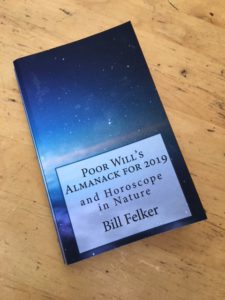Listen to Interviews with Bill Felker
WOCA, Ocala, Florida: Interview
WQLX, North and South Dakota: Farm Talk Interview
https://drive.google.com/a/advantageww.com/file/d/1YOvbKjasAB0LeAiR91xZ01SFvHRXUnva/view?usp=sharing
WKBN, Youngstown, Ohio: Interview
https://drive.google.com/open?id=1VwLCwssyMTVymWNFM8DHq2BwCTFS2hSB
Order Poor Will’s Almanack for 2020 from Amazon:
amazon.com/Poor-Wills-Almanack-2020-Collection/dp/1709112972/ref=sr_1_5?keywords=bill+felker&qid=1575159541&sr=8-5
Poor Will’s Almanack for 2020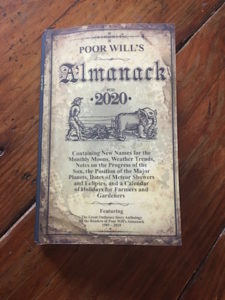
Containing New Names for the Monthly Moons, Weather Trends, Notes on the Progress of the Sun, the Position of the Major Planets, Dates of Meteor Showers and Eclipses, and a Calendar of Holidays for Farmers and Gardeners
And Featuring
The Great Outhouse Story Anthology
by the Readers of
Poor Will’s Almanack: 1985 – 2019
Sample Month with Outhouse Stories
January
The Sun: Perihelion, the point at which the Earth and the Sun are closest to one another, occurs on January 5 at 3:24 a.m. The Sun enters the Late Winter sign of Aquarius on January 20, and its declination passes 17 degrees 31 minutes by the 31st, one quarter of the way to spring equinox.
Phases of the Pussy Willow Cracking Moon and the Lambing and Kidding Moon
December 26: The Pussy Willow Cracking Moon is new at 12:13 a.m.
January 1: The moon reaches apogee at 8:31 p. m
January 2: The moon enters its second quarter at 11:46 a.m.
January 10: The moon is full at 2:22 p.m. (Penumbral lunar eclipse not visible in North America)
January 13: The moon reaches perigee at 3:22 p.m.
January 16: The moon enters its final quarter at 8:15 p.m.
January 24: The Lambing and Kidding Moon is new at 1:45 a.m.
January 29: The moon reaches apogee at 4:29 p.m.
The Planets: Venus is the evening star in Aquarius this month. Mars is the red Morning Star in Ophiuchus. Jupiter and Saturn are in Sagittarius, visible just before first light this month.
The Stars: The bedding plant stars of fertile Pisces lie in the west at midnight, and the stars of late-gestation feeding for sheep and goats follow close behind in Aries. Orion lies in the center of the southern sky, his sword raised for pruning as well as hunting. To the east, Cancer favors the ordering of seeds, and Leo foretells the broody hens.
The Shooting Stars: The Quadrantid Meteor Shower occurs between January 1 and January 5, and reaches its best (up to 40 meteors in an hour) on January 3 and 4.
Meteorology: High-pressure systems are due to cross the country on or around the following dates: January 1, 5, 10, 15, 19, 25, 31. If strong storms occur this month, weather patterns suggest that they will happen during the following periods: January 1-2, 8-12 and 19-24. New moon on December 26 and January 24, and full moon on January 10 are likely to intensify the cold fronts due near those dates.
The Great Outhouse Story Collection
- An Outhouse Shellacking
By Bill Wiseman of Vevay, Indiana
Many years ago, my Uncle Cornelius was an outhouse specialist. He had built and repaired outhouses for years in the hills of Kentucky. He had the reputation of being the best in the area.
One day, he decided to do a little repair work on his own outhouse. Aunt Wilma was gone for the day, and Uncle put new screen in the vent to keep out the wasps and small critters and also put a new latch on the door. Then he decided to sand the seat nice and smooth and put on a coat of shellac, and then off he went to the field to work.
Aunt Wilma came home a little early and went out to set a spell in the outhouse and brought her quilting quarterly along. Well, that shellac didn’t dry, and poor Auntie got stuck on the seat.
Five hours later, Uncle Cornelius came in from the South 40 and heart Auntie hollering back in the outhouse, madder than a hornet.
Well, Uncle had a deuce of a job getting her free – I’ll not mention how. But he never shellacked an outhouse seat again!
- Funny But Lucky
By Sylvia Basinger, Bluffton Ohio
When I was twelve years old, my uncle and aunt invited me to go along with them to Pennsylvania. I asked my folks, and they said I could
This was a great treat for me. It was the first time I left the state of Ohio.
When we arrived at our destination, Aunt Stella had an old-fashioned, cook-stove meal waiting for us. We all ate together.
And then, of course, I looked the outdoors over. My aunt and uncle had a privy, and it was some distance from their house. I went into the outhouse and sat down on the hole.
Suddenly I heard some pigs grunting real loud underneath me! I jumped up off the toilet seat and saw, to my surprise, two half-grown hogs down below!
Luckily, I hadn’t been bitten, but I screamed anyway and ran to the house to tell my Aunt Stella what’d happened. She told her husband, but he just said: “Oh, I cleaned out the outhouse pit, and I forgot to put back the boards.”
Those days are gone forever, but the memory will always remain with me.
- The Cherry Bomb Kid
by Donna Schiver, Clyde, Ohio
I will try to tell you about my husband’s nickname (Cherry Bomb Kid)… as you will see, he earned the name honestly.
In the early 1960s, there were outhouses in the country that were still used, and my husband’s family had one of these. Now he and his brothers were mischievous boys, always doing something for a joke or pulling pranks and always in trouble with their mother.
This one day, the boys had a bunch of bird control firecrackers that farmers used to keep birds out of crops; some people called them cherry bombs. They were outside doing the usual things like blowing up tin cans or scaring house cats when they aw their sister go into the outhouse.
My husband thought it would be fun to scare her. He wasn’t sure what the cherry bomb would do, but he just had to try it. So he crept up to the back of the outhouse and dropped the cherry bomb into a rat hole behind it and waited.
What he didn’t know that his mother was in there too.
His sister heard a hissing and thought there was a snake in the outhouse and started yelling. Their mother was looking for the snake when the cherry bob exploded.
It was a sight never to forget, and still makes my husband laugh so hard that tears roll down his cheeks to this day: The door flew open and smoke rolled out, followed by two creatures that looked like something from horror movies. There were pieces of toilet paper hanging everywhere; they were coughing and wiping stuff from their eyes and yelling my husband’s name because they knew he did it.
My husband and his brothers fell to the ground and roared with laughter and tears for a good hour. But when their mother caught up with them, it was their turn to cry.
We always laugh about the incident, but what really takes the cake is that at one of his mother’s birthday parties, they decided to remind her of the cherry bomb kid, so my husband and his bothers made a little outhouse and put it on her birthday cake with a firecracker inside of it.
Then they lit the firecracker which promptly blew up. There was frosting everywhere, but it brought lots of laughter and memories that we will always treasure!
Order your copy:
amazon.com/Poor-Wills-Almanack-2020-Collection/dp/1709112972/ref=sr_1_5?keywords=bill+felker&qid=1575159541&sr=8-5
Also available from Amazon:
The Weather Book of Poor Will’s Almanack
https://www.amazon.com/Weather-Book-Poor-Wills-Almanack/dp/1701296101/ref=sr_1_1?keywords=bill+felker&qid=1575160524&sr=8-1
The weather information in this Weather Book is based on my charts of fractal weather patterns I made between 1978 and 2019. Readers of my weekly and monthly columns throughout the United States have used these estimates since 1984.
My interest in the weather began in 1972 with the gift of a barometer. My wife, Jeanie, gave the instrument to me when I was succumbing to the stress of school in Knoxville, Tennessee, and it became not only an escape from intense academic work, but the first step on the road to a different kind of awareness about the world.
From the start, I was never content just to watch the barometric needle. I had to record its movement. I was fascinated by the alchemy of my charts and graphs that turned rain and Sun into visible patterns, symbols like notes on a sheet of music.
From my graphs of barometric pressure, I saw that major high-pressure systems move across the United States an average of once every five to six days, and approximately 80 significant highs cross the Mississippi River in a year. Fronts move more quickly in the colder months. October through March can bring up to eight waves of high pressure every 30 days. The warmer months between April and September are more likely to have six or fewer fronts; June, July and August sometimes only produce two or three significant systems.
The weather records also showed that each week of the year was no less distinct than each month. In addition, the study of weekly weather revealed pivotal times in the year: days or groups of days during which the seasons obviously shifted.
A short apprenticeship told me when important changes would occur and what kind of weather would take place on most any day. That information was expressed in the language of odds and percentages, and it was surprisingly accurate. Taking into consideration the consistency of certain patterns in the past, I could make fairly successful estimates about the likelihood of the repetition of such patterns in the future. The pulse of the world was steadier than I had ever imagined.
The more I learned about the natural cycles in and around my home in southwestern Ohio, the more I found applicable to the world beyond the village limits. The microclimate in which I immersed myself gradually became a key to the extended environment; the part unlocked the whole. My backyard gnomon that measured the movement of the Sun along the ecliptic also measured my relationship to every other place on Earth.
The Pulse of the Earth
Major high-pressure systems cross the United States an average of once every five to six days, and 60 to 65 systems pass through the Midwest in a year. Fronts move more quickly in the colder months; October through March can bring up to eight waves of high pressure every 30 days. The warmer months between April and September are more likely to have six or fewer fronts; June, July and August sometimes only produce two or three significant systems.
This regular pulse that characterizes the planet’s atmosphere was first recorded in detail by 16th century almanackers. It still forms the basis for annual predictions in some of today’s commercial almanacs, and it can be used by anyone who keeps a weather journal to gauge the likelihood for rain or sun, heat or cold on any given day.
Within the rhythm of the earth’s breath across the countryside, there are seasonal shifts that occur at certain predictable intervals. The fifth front of the year, for example, is often followed by pleasant weather, the January thaw. The last high-pressure bank of January is also relatively mild, bringing a warm-up near Groundhog Day. Early spring, when pussy willows start pushing out and snowdrops bloom, arrives after the eleventh cold front of the year near the 15th of February.
Almost every season turns on a specific weather milestone that develops at a specific time and is predictable within a couple of days. Changes in plants, animals and even people keep pace with those events and can be measured by them. The weather year is consequently a template for all the other cycles that take place around us. It is a dynamic metronome, a resource of cadence and balance.
Weather and Fractal Patterns
Like almanackers and other horoscopers (time watchers), some Chaos Theory physicists look at patterns in nature, and they have come up with notions that support the ancient use of barometric patterning in tracking and predicting likely weather scenarios. (Chaos Theory is concerned, in part, with discovering order in patterns or systems that previously were thought to be completely random.)
In the late 1970s, an IBM research scientist named Benoit Mandelbrot looked at fluctuations in all kinds of phenomena, from the stock market to cloud formations. He came to the conclusion that these very different occurrences were related to one another, and that they revealed an underlying force that pervaded every aspect of life on Earth.
In each of the events he studied, Mandelbrot found “self-similar” systems, which he called fractals. It is probably easier to picture a fractal than to define it. Imagine an electrocardiograph analysis of your heartbeat. The ups and downs are arranged on the paper in an orderly fashion, but never at exactly the same intervals. Or picture a month or two of a graph of the Dow Jones averages. That’s a fractal pattern graph.
Although a weather graph of temperature or barometric pressure may chart very different activities and show much greater variability than the electrocardiograph record. Mandelbrot would posit that all such fractal records are showing us a life principle, not unlike a yin-yang law, which underlies not only weather, stocks and heartbeats but almost everything from the shape of ferns and fiords to the filigree in lungs and leaves.
That there is a relationship between heart rhythms, barometric rhythms, temperature rhythms, the patterns of clouds, the stock market and even the shape of frost on the windshield of my truck in winter, is apparently not a matter of too much debate, at least among some Chaos Theory physicists. All of the systems mentioned can be charted as fractals, and a visual analysis of their designs reveals their broad similarity.
Graphs of barometric pressure reveal many of the topographical patterns of the seasons. For example, August’s barometric configurations are slow and gentle like low, rolling dunes. Heat waves show up as wide plateaus. Thunderstorms are sharp, shallow troughs in the mellow waves of the atmospheric landscape.
At the close of Late Summer, the year begins its ascent to the steep cliffs of December. Throughout Early Fall, the barometric waves become stronger; the high-pressure peaks become taller; the lows are deeper, with almost every valley bringing rain or snow.
Middle Fall is the rough piedmont of another country, stripping foliage, putting buds into dormancy, burning away the undergrowth and revealing the dark hillsides. At the end of Late Fall, December’s great range of cold and snow fills the horizon. Beyond it lies another immense upland, the frigid, high plateau of Deep Winter in which nothing ever seems to grow or change until the ground crumbles and gives way, shattered by thaws, and time tumbles down into the sudden, stormy gorge of March.
Estimating the Weather from Home
Although The Weather Book descriptions are based on notes in southwestern Ohio, they are applicable throughout the Lower Midwest and at average elevations along the 40th Parallel. With practice, they can be used throughout the hemisphere in conjunction with personal or local weather data.
The rhythmic passage of weather systems across the United States can be tracked as well from one’s own home and microclimate as from any other location. Local barometric fluctuations reflect a relationship between backyard weather and weather all across the country.
When the barometric pressure falls and rain or snow occurs in my home town of Yellow Springs, Ohio, I know that a cold wave is sweeping across Illinois and Indiana, will reach me in a few hours, and arrive in Pennsylvania within a day. Like swells in the ocean, atmospheric waves occur at relatively predictable intervals, and no satellite is needed to see them, no technology more recent than that of the 17th century.
Since the general pivot times of seasonal change are dependent upon the regular patterns and predictable characteristics of these high and low pressure systems, the same key patterns that cause my local weather to change usually bring about similar changes to the north and south.
For example, although early spring comes to central Ohio in the third week of February and does not come to Minneapolis until April, a shift towards milder conditions does occur in Minnesota and throughout the country in the middle of the year’s second month—be it accompanied by blooming snowdrops and aconite or simply by a slight modification of temperatures from highs in the upper 20s to highs in the lower 30s.
Since the rise and fall of temperatures in other parts of the North America keep pace with the temperatures in my village, my thermometer can be used to estimate the weather throughout the hemisphere. From the 40th parallel—which lies just a few miles from Yellow Springs—the coldest months show temperatures about two to three degrees colder every one hundred miles north, two to three degrees warmer every hundred miles south. In the milder months of summer, the differences shrink to one degree per hundred miles.
With those broad guidelines and a map, I can calculate temperatures almost anywhere east of the Mississippi, and estimate with some accuracy the location of the seasons at any time of year. From its birth along the Gulf Coast in January, spring comes north one hundred miles every week. Making the journey to central Ohio in about two months, it typically brings crocus to Chicago by the middle of March, and into the country’s northern rim by the end of April or the first of May.
In autumn, killing frosts move down from the Canadian border at about the same rate as spring warmth approaches from the Caribbean, striking near Winnipeg in the first weeks of September, reaching the Ohio Valley toward the end of October, and arriving in Georgia by the end of November or the first weeks of December. Although conditions for a garden-killing freeze can vary from yard to yard, to say nothing about from state to state, one position on the seasonal trajectory suggests the approximate positions of other locations as well.
And although the leaf-turn cycle is as dependent upon the sun as upon the weather, fall colors typically follow the frost: aspens peak in the Rocky Mountains in early to mid September; a month later, the country’s midsection begins the best of its maple color, and most deciduous trees lose their leaves in the South by late November. Wherever a person may be during the fall or any other season of the year, he or she can use that knowledge to unlock the door of that movement elsewhere.
How to Use The Weather Book
First, check the monthly overview at the beginning of each month’s section to see if and when a cold front may be approaching. Often milder weather occurs in advance of a cold front, and cooler weather usually follows.
Second, check the characteristics of the approaching cold front in the front description for Wintercount, Springcount, Summercount or Autumncount that briefly describe these weather systems. These descriptions follow the monthly overviews.
Third, check The Weather Book’s weekly weather summary for the week of the time in question, and then read the daily weather summaries around that period. These summaries do not offer predictions, but they do present an overview of the kind of weather that has occurred in the past around the arrival of the weather system in question.
Fourth, check the phase of the moon. You don’t have to be an astronomer to do this. Your weather app or a newspaper can provide this information. What you are looking for is pretty straight forward: Full moon and new moon bring stronger frontal weather activity a significant percentage of the time.
Note that if the moon is at perigee (its position closest to Earth), lunar influence will be greater still. When a “Supermoon” occurs, the full moon is at its point nearest the Earth, and weather conditions are most likely to be stormy. This information may or may not be always be available from your sources, but you should always be able to find information about full or new moon.
Are Almanack Weather Estimates Practical?
While this weather book is the result of a local record, readers of Poor Will’s Almanack from Wyoming to Vermont have found it useful since 1984. Keep track of your own weather and let me know how Almanack Weather principles work for you. Remember that The Weather Book descriptions and data portray trends and cycles as well as what has happened in the past in a specific location.
Your weather, of course, will be somewhat different, but with practice, you will hopefully be able to track the correspondence between what happens in your yard and what has happened in southwest Ohio along the 40th Parallel. And as the climate changes, you should be able to become more aware of how weather on any particular day varies from previous conditions.
Write me at P.O. Box 431, Yellow Springs, Ohio 45387 or at [email protected].
Even more details and almost forty years of nature notes are available in my Daybook for the Year available in 12 volumes from Amazon.
Also available from Bill Felker on Amazon:
Home is the Prime Meridian: Almanac Essays in Search of Time and Place and Spirit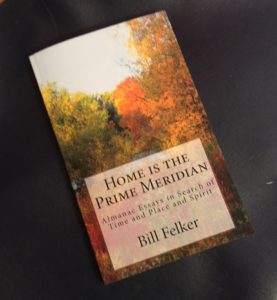
The essays that focus on seasonal time blend the author’s observations of events in nature with his reflections on change and passage. For example, in “Checking for Spring,” he counts the kinds of buds on the trees and bushes that surround his yard, feeling reassured by their number and promise. In “The Archipelago of Early Spring,” he describes the landscape of early spring in and around his village, finding a topography of flowers that embodies the advance of the year. He uses synecdoche in “Strawberry Summer” to link parallel seasons of blossoms to the strawberries of June. In “Autumn Samadhi,” he names an accumulation of loss, “counting what no longer holds,” and making “an inventory of emptiness, cued only by memory and the more durable, woody scaffolding that binds the seasons.”
Felker’s selections about his sense of place explore his relationship with the local seasons, with his house, with his town and its surrounding parkland. “My home in Yellow Springs is a private observatory,” he says in “Homely Gnomons.” And tracking and marking the movement of the Sun on the walls of his rooms, he makes a map of his personal history, “with souvenirs following the shadows.” In “Merak and Dubhe,”he describes how he uses the flora of his neighborhood to track the progress of the year in other locations. “The Pond” is a meditation on aging and dreams of youth. In the pond near his house, Felker says, “the horizon was not the globe’s round, aloof, ever receding promise. This world was flat. This horizon was accessible, touchable. My reach for once did not exceed its grasp. I gave in to the attainable sea, its borders as fixed and finite as my own.” The final essay of the collection explains how his home is the point from which his entire life is measured. Home, like a spiritual Greenwich point, is the Prime Meridian.
The seasons, the fauna and flora are all parts of Felker’s personal odyssey. In “Camel Crickets in the Tub,” he compares the crickets’ apparent lack of common sense with his own. In “Watching Romuald,” a frog helps him to understand meditation. In “The Visitor,” a yellow-bellied sapsucker teaches him how to fight depression. He goes to confession to rodents in “Mice in a Mug.” He relives a humiliation in his childhood and learns its meaning in “Talking Mosquito.” He thinks about free will in the context of spring in “The Sweetest Way.” He longs for a benign God in “A Community of Koi in Winter.” He muses about mortality and the rebirth of nature in spring with the essay, “In Suspense.” He writes: “I wonder about the seasons and the meaning of the seasons of the landscape because I am wondering about my own seasons and what they mean. I watch them, and I am in suspense because I don’t know exactly how they will turn out.”
Throughout this collection, Felker explores place in nature within a context of observation and spiritual reflection. In HOME IS THE PRIME MERIDIAN, the sky, the land, plants and animals are touchstones for identity and meaning.
Order from Amazon:
Or Visit the Book Shop to order an autographed copy.
A REVIEW OF HOME IS THE PRIME MERIDIAN BY THE KIRKUS REVIEW
“A brief, intense, and entirely enjoyable tour of nature.”
“When I go too far out, I need to gather my landmarks of home around me,” writes radio broadcaster and veteran almanac author Felker (Poor Will’s Almanac for 2018, 2017, etc.) in his short, aphoristic new work of reflections on nature. “Distant locations only make sense against my local gauge.” The more he understands where he is, he tells his readers, the more he understands himself. Consequently, he lavishes extraordinary care and attention on his small plot of field and woodland in Yellow Springs in southwestern Ohio, often characterizing the locus of home as the “prime meridian” in even the most far-ranging voyages.
In the long tradition of nature diaries, he anchors dozens of short pieces on explorations of the seasons of the year, the moods of the weather, and, most of all, the characters and behaviors of all the animals he spots, particularly birds. Several of the architects of this kind of writing, from Ralph Waldo Emerson to John Burroughs, are quoted or paraphrased with obvious affection, and Felker’s animal portraits are warmly enhanced by what he freely admits is a liberal amount of anthropomorphizing. His birds and woodland creatures are often as metaphorical as they are material. He’s a careful and meticulous observer who nevertheless seldom falls into the trap reserved for scrupulous spectators: being tedious. He’s saved from this because he commands a light-footed prose style and he keeps his vignettes very brief.
Felker has been crafting these almanac-style entries for many years, and his experience shows not only in the smoothness and economy of his storytelling, but also in the winning combination of humility and poetic insights he’s clearly mastered. He’s delightful company on the page, in everything from his subtle, sensory-heavy evocations of the seasons (winter being a specialty) to his accounts of the stars and his lush descriptions of the natural world’s various inhabitants, captured even in a quick list of the region’s bird life: “The sparrows, like starlings, staying tight to the motions of the flock; the acrobatic chickadees swooping in and out, remaining only seconds to grasp their sunflower seed and fly off; the wary, fluttering titmice; the blue jays, harsh and bullying; the hopping, syncopated nuthatches exploring upside down.” These passages are often layered with musings about the author’s moods—the immediate and sometimes-odd ways his feelings intersect with the flora and fauna he stumbles on (one of the book’s closing scenes, involving a group of pantry-raiding mice, is an especially touching example).
The tone throughout remains highly personal, almost confessional, which often adds to the charm of the work. The author’s knowledge of the plants and animals in his realm is encyclopedic but never comes across as pedantic, and the resulting almanac is a tightly focused and wonderfully executed example of small-bore nature writing.
Order from Amazon: https://www.amazon.com/Home-Prime-Meridian-Almanac-Essays/dp/1544134622/ref=sr_1_4?ie=UTF8&qid=1545154599&sr=8-4&keywords=bill+felker
Or, for an autographed copy, visit the Book Shop on this site.
A Review of Home is the Prime Meridian by the OnlineBookClub.org
Home is the Prime Meridian: Almanac Essays in Search of Time and Place and Spirit by Bill Felker is a collection of non-fiction essays set in Yellow Springs, Ohio. The essays vary in length from one to four pages. As the title suggests, the essays focus on three topics: time, place and spirit. Told in sequence, these essays follow the seasons one experiences in a year: winter, spring, summer and fall.
Home is the Prime Meridian is a literary lover’s delicacy. The author utilizes masterful control over language to touch upon all five senses. Felker further adds an emotional element to his writing to create a strong connection between the reader and the enchanting setting in which these essays take place. The tone throughout the collection is impassioned, sometimes nostalgic, and at other times, hopeful, but each essay is imbued with the same sincerity and reverence for nature. The writing is crisp, and the author’s word choices are eloquent, making one want to read, reread and reread again the short essays compiled in this collection.
The book is a collection of essays, but I think the author’s work would better be categorized as poetic, story-telling non-fiction. His way with words clearly sets the scene for the reader and transports one to the exact time and place being written about. Although I have never been to Yellow Springs, Ohio, I could taste the harshness of the cold winter months; I could see the emerging color in the spring; I could hear the tranquil summer days, and I could feel the loss brought by autumn. Instead of feeling like an observer looking in on the author’s memories, I felt as if I was in a trance, imagining and remembering the very things described in each essay.
There are forty-two essays in this collection, and each one stood out as a unique and equally intriguing work of art. Many times, collections like this can feel repetitive or become tedious to read due to similar writing and use of the same literary devices over and over again. However, that is not the case with Home is the Prime Meridian. Each essay is thought provoking in its own way: some essays are lighthearted and easily decipherable, others are more obscure and require interpretation. However, I found each essay was as enjoyable as the next, and none failed to capture my attention. Further, whether we are reading about plants, animals, constellations or landscapes, each poem is somewhat introspective and all revolve around so much more than just the natural elements we think we are reading about. Loss, aging, spirituality, change, mortality, and the perpetual cycle of life are just some of the themes touched upon in Felker’s essays.
I devoured these essays one by one. Each time I thought I had found my favorite essay, another came along and impressed me even more. “Wow” was my reaction to the author’s words over and over again. The layers of meaning behind the short, sometimes simple words had me in awe of this writer’s ability to mold language and evoke emotions long buried in my mind. This is a collection I will cherish and return to frequently. I strongly urge lovers of nature, earth and the naturalistic to read this collection. I have never felt so strongly about a collection of essays; Home is the Prime Meridian is truly a treat for the senses and a writer’s delight. In my mind, this book deserves far more than four stars, but as that is the highest award I can give, I rate Home is the Prime Meridian a strong 4 out of 4 stars.
Order from Amazon: https://www.amazon.com/Home-Prime-Meridian-Almanac-Essays/dp/1544134622/ref=sr_1_4?ie=UTF8&qid=1545154599&sr=8-4&keywords=bill+felker
Or, for an autographed copy, visit the Book Shop on this site.
Also from Bill Felker
Poor Will’s Almanack for 2019 and Horoscope in Nature
A handbook for watching time in nature (horoscoping) with which readers may use the Sun, Moon, stars, planets, shooting stars, weather patterns, the farm and garden year, blooming plants and other living creatures to better understand and live with the external forces that shape their lives.
Order on this site: for an autographed copy: https://www.poorwillsalmanack.com/product/poor-wills-almanack-for-2019/
Or Order from Amazon:
https://www.amazon.com/Poor-Wills-Almanack-2019-Horoscope/dp/1722969369/ref=sr_1_1?ie=UTF8&qid=1537039827&sr=8-1&keywords=BILL+FELKER
The word horoscope comes from two Greek words, hora, which means hour or time, and skopos, which means observer. The time observer is a horoscoper, and for the horoscoper who watches the seasons, an “almanack horoscope” can offer a useful guide to the galaxy as well as to one’s own neighborhood.
In The Emerald Tablet, an ancient text by Hermes Trismegistus, the author attempts to explain the astrological mysteries of the cosmos. The work contains the phrase: “As above, so below.”
Indeed the land does reflect the sky above it, and the Earth watcher can create constellations and stories no less than the traditional astrologer. For the horoscoper, the landscape is rich with lessons and with possibilities for alignments and predictions.
By focusing on events in nature, the time watcher not only observes how the weather and the movement of the Sun, Moon, stars and planets are connected to the seasons but also how events on Earth reflect what happens in the sky and how all of these events can be related to human emotions.
\
Listen to Bill’s latest interview with Vic Mckunas on the Book Nook, and access all Recent Poor Will’s Almanack Segments on NPR station, WYSO.
http://www.wyso.org/programs/poor-wills-almanack
More Books by Bill Felker
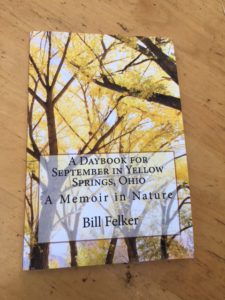 A Daybook for September in Yellow Springs, Ohio
A Daybook for September in Yellow Springs, Ohio
Contains all my September notes between 1981 and 2017, including daily and weekly weather estimates, summaries of the progress of the season and a calendar of blooming plants, all applicable to the Lower Midwest, the Middle Atlantic region and the East.
Order from www. amazon.com. Search for Bill Felker
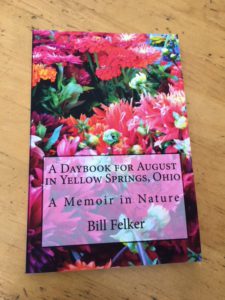 A Daybook for August in Yellow Springs, Ohio
A Daybook for August in Yellow Springs, Ohio
Contains all my August notes between 1981 and 2018, including daily and weekly weather estimates, summaries of the progress of the season and a calendar of blooming plants, all applicable to the Lower Midwest, the Middle Atlantic region and the East.
Order from www. amazon.com. Search for Bill Felker
 Daybook for July in Yellow Springs, Ohio
Daybook for July in Yellow Springs, Ohio
Contains all my July notes between 1981 and 2018, including daily and weekly weather estimates, summaries of the progress of the season and a calendar of blooming plants, all applicable to the Lower Midwest, the Middle Atlantic region and the East.
With cover by Libby Rudolph
Order from www. amazon.com. Search for Bill Felker
A Daybook for June in Yellow  Springs, Ohio
Springs, Ohio
Contains all my June notes between 1981 and 2018, including daily and weekly weather estimates, summaries of the progress of the season and a calendar of blooming plants, all applicable to the Lower Midwest, the Middle Atlantic region and the East.
With cover by Libby Rudolph
Order from www. amazon.com. Search for Bill Felker
 A Daybook for May in Yellow Springs, Ohio
A Daybook for May in Yellow Springs, Ohio
Contains all my May notes between 1981 and 2017, including daily and weekly weather estimates, summaries of the progress of the season and a calendar of blooming plants, all applicable to the Lower Midwest, the Middle Atlantic region and the East.
With cover by Libby Rudolph
Order from www. amazon.com. Search for Bill Felker
A Daybook for April in Yellow Springs, Ohio
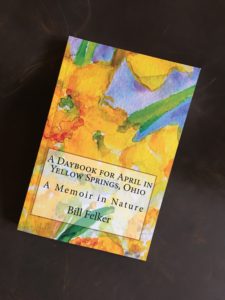 Contains all my April notes between 1981 and 2017, including daily and weekly weather estimates, summaries of the progress of the season and a calendar of blooming plants, all applicable to the Lower Midwest, the Middle Atlantic region and the East.
Contains all my April notes between 1981 and 2017, including daily and weekly weather estimates, summaries of the progress of the season and a calendar of blooming plants, all applicable to the Lower Midwest, the Middle Atlantic region and the East.
Order from www. amazon.com. Search for Bill Felker
A Daybook for March in Yellow Springs, Ohio
Contains all my March notes between 1981 and 2017, 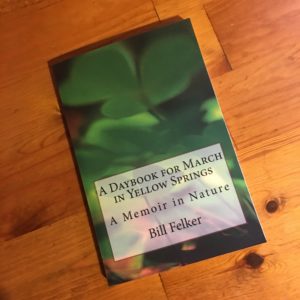 including daily and weekly weather estimates, summaries of the progress of the season and a calendar of blooming plants, all applicable to the Lower Midwest, the Middle Atlantic region and the East.
including daily and weekly weather estimates, summaries of the progress of the season and a calendar of blooming plants, all applicable to the Lower Midwest, the Middle Atlantic region and the East.
TO ORDER AUTOGRAPHED COPIES VISIT THE BOOK SHOP ON THIS SITE.OR ORDER FROM WWW.AMAZON.COM UNDER BILL FELKER
Since 1984, Poor Will’s Almanack by Bill Felker has provided a guide to living in harmony with the Earth. Bill’s weekly and monthly almanack columns currently appear in more than a dozen regional and national publications. Learn more about Bill Felker and the history of Poor Will’s Almanack »
You can hear Bill’s weekly radio segment on NPR station WYSO every Tuesday morning at 6:35 and 8:35 (EDT). You can listen to podcasts and read the almanack essays following the link on this site.
Explore Bill’s Phenology Journal for descriptions of the many seasons of the year.
His Almanack Essays offer reflections on how his observations of natural phenomena have formed his personal philosophy.
His Daybook offers a daily record of common events in nature in and around his home in Yellow Springs, Ohio.


